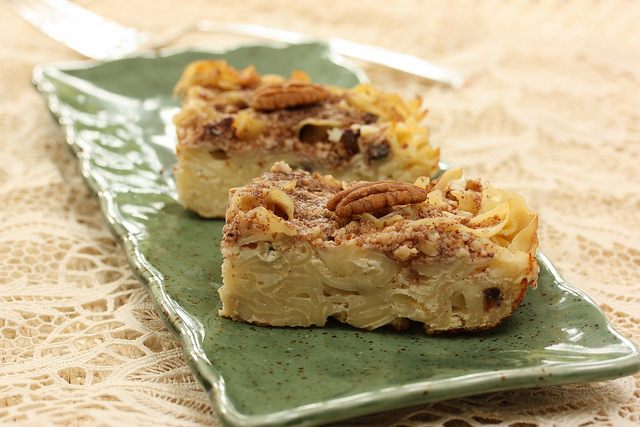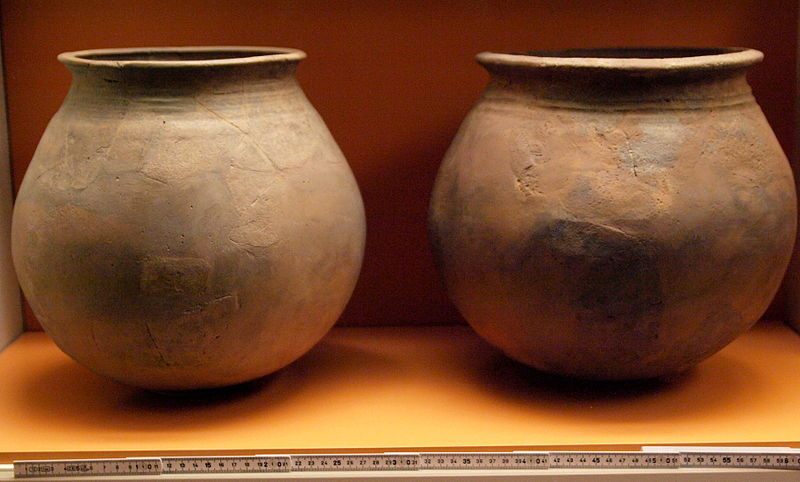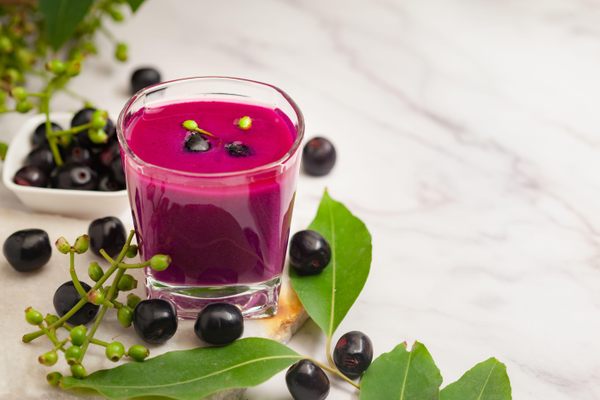I Tried to Recreate Medieval Kugel and Ended Up With a Fruitcake

What potato kugel looks like today (Image: Rebecca Siegel/Flickr)
In modern Jewish-American cooking, kugel appears as an encumbrance on holiday dinner tables, a casserole of tradition, guilt, and heavy starch. But kugel, according to centuries-old culinary tradition, is supposed to be round. Not a flat disc, but a sphere.
It’s right there in the name: kugel, in German, means sphere or ball. Until about 150 years ago, when kugel became the Jewish version of baked casserole, it was cooked in a rounded ceramic pot, called a kugeltopf, that gave the dish its name.
When I was a kid, my family’s favorite was a kugel made of egg noodles, cottage cheese, pineapple, cinnamon, raisins, more eggs and sugar, a concoction not unlike the Midwestern tuna noodle masterpiece, only cloyingly sweet. I have a hard time, though, believing that anyone who didn’t grow up with kugel would choose it as a foodstuff.
Potato kugel is common; other kugels use matzah or noodles as their main ingredient. Jerusalem kugel, which some people claim is very tasty, is a baked dish that mixes cooked spaghetti with caramel, black pepper and eggs. Matzah kugel, popular at Passover, is broken up matzah, held together with eggs and more matzah and flavored with onion, salt, and pepper. Potato kugel is one of the worst uses of potatoes possible, unless boiled potatoes make up most of your diet and baking shredded potatoes with eggs, onions and oil counts as a pleasant improvement.
But kugel has a history stretching back eight or nine centuries, and the kugel Americans eat today is a product of our particular time and place, where wealth and home ovens have overlapped with recipes from impoverished villages of Eastern Europe.
I wondered: what was kugel originally meant to be? And is it possible that before potatoes and noodles took it over that it actually tasted good?

Noodle kugel (Photo: Meal Makeover Moms/Flickr)
The story of kugel, the way Gil Marks tells it in his Encyclopedia of Jewish Food, begins with dumplings. In medieval Germany, dumplings were a culinary innovation, only recently arrived from Asia. These were simple, doughy lumps. They weren’t filled with meat, potatoes or cheese; they were flour, fat, water, and maybe egg, rolled into balls and cooked in pots of simmering liquid.
Around the same time, the idea for a stew was making its way from North Africa into Spain, through France (where it may have taken its name, cholent, from chaud-lent, slow heat), and into Germany. Think of a tagine, a pot of tender lamb, chickpeas and spices, adapted slowly into a European stew. There were fewer spices, different beans, barley and potatoes added in, beef substituted for lamb.
In Germany, the slow-braise style, wherein meat and beans and vegetables were left to cook at barely a simmer from Friday before sundown into the next day, for a Jewish Sabbath meal, met these simple dumplings. Jewish cooks started dropping dumpling batter into the hearty stew and letting the whole mess cook overnight.
This is a good enough idea that the British chef Jamie Oliver still has a recipe for exactly the same combination Marks describes, a soupy beef stew studded with white, round dumplings. Oliver’s recipe warns that the “perfectly stodgy and comforting” dumplings “will suck up quite a bit of moisture” in the 30 minutes he recommends simmering them in the stew. Jewish cooks would have had to leave the dumplings in for longer, since they had to prepare the dish before Shabbat’s restrictions on work began.
Maybe the dumplings sucked up too much broth to be desirable; probably they fell apart, as dumplings so often do. Or maybe, as Marks suggest, Jewish cooks simply picked up another way of cooking. For whatever reason, they started placing the dumpling batter in a kugeltopf, sticking the kugeltopf in the stew, and allowing the dumpling to steam overnight, without soaking up any valuable liquid. That was the beginning of kugel.

Kugeltopf (Photo: Bullenwächter/Wikimedia)
For centuries after that, the basic idea of kugel didn’t change dramatically. The list of ingredients that made it into the kugeltopf, though, became more complicated. Savory kugel might have onions or chicken fat added in. On special occasions, kugel might incorporate dried fruits and spices. By mid-millennium, noodles had made their way to Germany, and those became part of kugel, too. When sugar became more available, cooks started making sweet kugels. And at some point, the concept of kugeltopf broadened from a simple round pot to more elaborate cooking vessels.
But when I went looking for a classic kugel recipe, the concept was still recognizable as the ”dumpling-in-a-pot” conceit that Marks describes. The earliest English-language recipes for kugel, on which I based mine, came relatively late in the game: one from the mid-19th century and one from a couple decades after that. They called for essentially the same ingredients, in similar proportions—flour, breadcrumbs, sugar, beef suet, eggs, and spices—cooked in a vessel placed into the middle of a stew.
For my own kugel experiment, I made a few changes. Instead of the more modern pans these recipes called for, I used a handmade ceramic mug, the vessel in my kitchen that most resembled a medieval kugeltopf:

A pretty close match, I thought (Photo: Sarah Laskow)
I looked for beef suet, but even though I live in the sort of New York neighborhood where strange animal fats are easy to come by, the butcher only had tallow (rendered beef fat) and the supermarket multiple forms of pork fat. So I subbed in the go-to fat of 20th century American Jewish cooks: margarine. I also decided to scale down the recipe to a smaller portion and place my makeshift kugeltopf in the middle of a slow-cooking pot of beans, instead of a complicated beef stew.
Making the dough was simple enough. I mixed sugar, flour, breadcrumbs and spices, cut the margarine into the dry ingredients, and added the egg. The mixture pulled into a damp ball of dough. After folding in the raisins, I covered the mouth of the kugeltopf with foil, tied a string around the top, and stood the cup in the middle of a simmering pot of beans. Lid on, the whole arrangement went into the oven. Now I just had to wait 12 hours.
When my kugel came out of the steamy pot in a browned lump, I was surprised. I hadn’t been sure what to expect: perhaps a tender, tiramisu-like pudding, poached gently through the night? A jiggly cake of spice and raisins?
This was not that. It looked like it might have been burnt on the outside, but when I cut it in half, the inside was brown, too. It was like a giant dumpling, spiced and studded with raisins. I wasn’t sure how to eat it, so I cut a slice. It looked a bit like fruitcake.
This was traditional kugel?

Kugel, as it was meant to be? (Photo: Sarah Laskow)
In case you were wondering, there are people who truly enjoy what kugel has become since its simple stew dumpling days. Last year, Avery Robinson confessed in a Tablet essay that “kugel is my favorite food.” He also wrote a master’s thesis on the dish and its particular role in Jewish life in the U.S.
Like medieval kugel, the kugel that today’s American Jews grew up with and still make today draws on specific geographical and historic influences. As Robinson tracks, before the second half of the 20th century, Jewish kugel was often lumped with other baked or steamed puddings. Even American Jewish cookbooks, with an assimilatory zeal, de-emphasized the Jewishness of kugel in favor of normalizing it.
But after World War II, Robinson writes, the “cultural loss of the Holocaust became a revival of sorts for Jewish cultural practice.” The eating of kugel, a tradition for many centuries, became important to carry forward, regardless of its actual merits.
This postwar kugel, though, was distinct in many ways. It was made in expansive casserole dishes, with rich ingredients—pounds of noodles, cartons of cottage cheese, half a dozen eggs, spices that once would have been dear. In the ’60s and ’70s, Jewish cookbooks codified this new version of kugel into what Robinson calls an “increasingly distinct and insistent” Jewish culture in America, rooted most clearly in the cooking of Eastern Europe. It had come a long way from its humble origins.
The medieval-style kugel that I made was pretty mediocre. It not only looked like fruitcake, it tasted like fruitcake. Only chewier. A better comparison might be a misshapen “health” muffin.
It’s possible that I didn’t do justice to traditional kugel. Maybe if I hadn’t scaled down the recipe, the result would have been lighter, fluffier, less fruitcake-like. Maybe I should have tried to make a simpler savory kugel that a medieval cook would have recognized. But those would have been minor improvements. Ultimately, any time you’re steaming batter overnight, it’s unlikely to turn out delicious.
The 19th century kugel is not a dish I plan to make again. Maybe the sweet, rich noodle kugel I grew up with is actually an improvement on the classic. Maybe kugel can never truly be saved.
But, really, this one wasn’t bad. I ate a couple of slices for breakfast.
Gastro Obscura covers the world’s most wondrous food and drink.
Sign up for our regular newsletter.
























Follow us on Twitter to get the latest on the world's hidden wonders.
Like us on Facebook to get the latest on the world's hidden wonders.
Follow us on Twitter Like us on Facebook